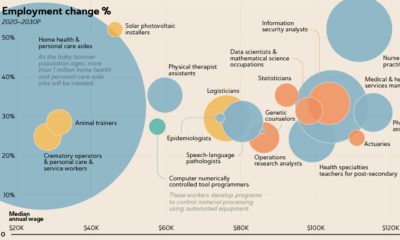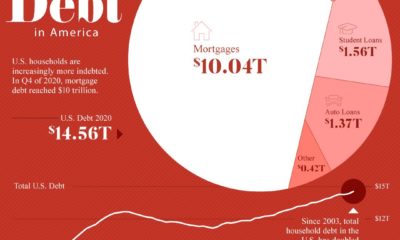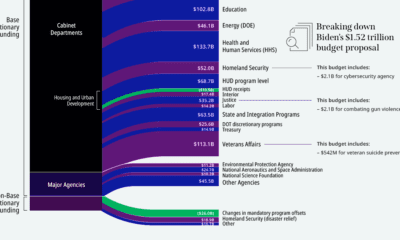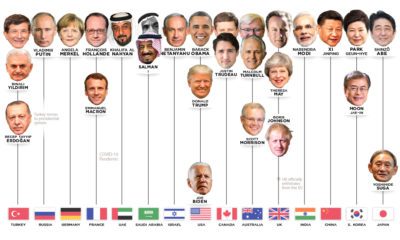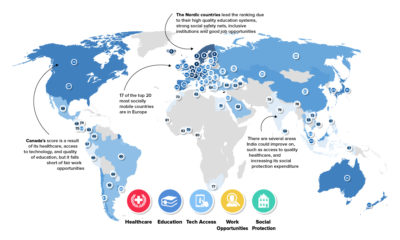Some leaders, like Alain Berset of Switzerland, specifically studied political science or law in university. Other leaders, such as Paraguayan president, Horacio Cartes, took a more roundabout path to the top, having studied aviation mechanics in the United States. The following maps, from SavingSpot, are an informative look at what national leaders around the world studied in school. Note: Hover over the maps to learn about leaders and their educational background.
North America
Donald Trump: America’s president holds a Bachelor of Science degree in Economics from the University of Pennsylvania Wharton School of Business. Justin Trudeau: Canada’s prime minister holds two degrees: a Bachelor of Arts in Literature from McGill University, and a Bachelor of Education from the University of British Columbia. Enrique Peña Nieto: Mexico’s president holds a law degree from Universidad Panamerica, and an MBA from the Monterrey Institute of Technology.
Europe
Angela Merkel: Germany’s chancellor has a heavy-hitting educational background. Merkel was educated at Karl Marx University, in Leipzig, where she studied physics from 1973 to 1978. She was awarded a doctorate for her thesis on quantum chemistry in 1986, and was recognized for her proficiency in Russian and mathematics. Emmanuel Macron: The French president studied philosophy at the University of Paris-Ouest Nanterre La Défense. As well, Macron obtained a master’s degree in public affairs at the Paris Institute of Political Studies. Stefan Löfven: Sweden’s prime minister took a more unconventional path to government. After completing military service in the Swedish Air Force, Löfven became a welder and subsequently a union representative. Eventually, Löfven became the first chairman of IF Metall, a newly formed trade union representing over 300,000 workers.
Asia
Vladimir Putin: Before joining the KGB in 1975, Putin studied Law at the Leningrad State University (now Saint Petersburg State University). Xi Jinping: Xi studied chemical engineering at Beijing’s prestigious Tsinghua University. During this time, China was fully immersed in the Cultural Revolution. Xi studied as a “Worker-Peasant-Soldier student”, which included blocks of time spent doing farm work and studying Marxism–Leninism–Mao Zedong thought.
Africa
John Magufuli: Tanzania’s president has an extensive educational background, earning masters and doctorate degrees in chemistry from The University of Dar es Salaam. Uhuru Kenyatta: The Kenyan president studied economics, political science, and government at Amherst College in Massachusetts.
South America
Michel Temer: Brazil’s president attended the Law School of the University of São Paulo, and later completed a doctorate in public law at the Pontifical Catholic University of São Paulo. Mauricio Macri: Before becoming an analyst at SIDECO Americana, Argentina’s president received a bachelor’s degree in civil engineering from the Pontifical Catholic University of Argentina. He also attended Columbia Business School, the Wharton School of the University of Pennsylvania, and the Universidad del CEMA in Buenos Aires.
Oceania
Malcolm Turnbull: Australia’s prime minister graduated from the University of Sydney with a Bachelor of Arts and a Bachelor of Laws, before earning a Bachelor of Civil Law at Brasenose College, Oxford. Enele Sopoaga: The prime minister of the tiny island nation of Tuvalu is one of many world leaders educated in the United Kingdom. Sopoaga earned a Certificate in Diplomatic Studies from Oxford University, and a master’s degree from the University of Sussex. on Even while political regimes across these countries have changed over time, they’ve largely followed a few different types of governance. Today, every country can ultimately be classified into just nine broad forms of government systems. This map by Truman Du uses information from Wikipedia to map the government systems that rule the world today.
Countries By Type of Government
It’s important to note that this map charts government systems according to each country’s legal framework. Many countries have constitutions stating their de jure or legally recognized system of government, but their de facto or realized form of governance may be quite different. Here is a list of the stated government system of UN member states and observers as of January 2023: Let’s take a closer look at some of these systems.
Monarchies
Brought back into the spotlight after the death of Queen Elizabeth II of England in September 2022, this form of government has a single ruler. They carry titles from king and queen to sultan or emperor, and their government systems can be further divided into three modern types: constitutional, semi-constitutional, and absolute. A constitutional monarchy sees the monarch act as head of state within the parameters of a constitution, giving them little to no real power. For example, King Charles III is the head of 15 Commonwealth nations including Canada and Australia. However, each has their own head of government. On the other hand, a semi-constitutional monarchy lets the monarch or ruling royal family retain substantial political powers, as is the case in Jordan and Morocco. However, their monarchs still rule the country according to a democratic constitution and in concert with other institutions. Finally, an absolute monarchy is most like the monarchies of old, where the ruler has full power over governance, with modern examples including Saudi Arabia and Vatican City.
Republics
Unlike monarchies, the people hold the power in a republic government system, directly electing representatives to form government. Again, there are multiple types of modern republic governments: presidential, semi-presidential, and parliamentary. The presidential republic could be considered a direct progression from monarchies. This system has a strong and independent chief executive with extensive powers when it comes to domestic affairs and foreign policy. An example of this is the United States, where the President is both the head of state and the head of government. In a semi-presidential republic, the president is the head of state and has some executive powers that are independent of the legislature. However, the prime minister (or chancellor or equivalent title) is the head of government, responsible to the legislature along with the cabinet. Russia is a classic example of this type of government. The last type of republic system is parliamentary. In this system, the president is a figurehead, while the head of government holds real power and is validated by and accountable to the parliament. This type of system can be seen in Germany, Italy, and India and is akin to constitutional monarchies. It’s also important to point out that some parliamentary republic systems operate slightly differently. For example in South Africa, the president is both the head of state and government, but is elected directly by the legislature. This leaves them (and their ministries) potentially subject to parliamentary confidence.
One-Party State
Many of the systems above involve multiple political parties vying to rule and govern their respective countries. In a one-party state, also called a single-party state or single-party system, only one political party has the right to form government. All other political parties are either outlawed or only allowed limited participation in elections. In this system, a country’s head of state and head of government can be executive or ceremonial but political power is constitutionally linked to a single political movement. China is the most well-known example of this government system, with the General Secretary of the Communist Party of China ruling as the de facto leader since 1989.
Provisional
The final form of government is a provisional government formed as an interim or transitional government. In this system, an emergency governmental body is created to manage political transitions after the collapse of a government, or when a new state is formed. Often these evolve into fully constitutionalized systems, but sometimes they hold power for longer than expected. Some examples of countries that are considered provisional include Libya, Burkina Faso, and Chad.


